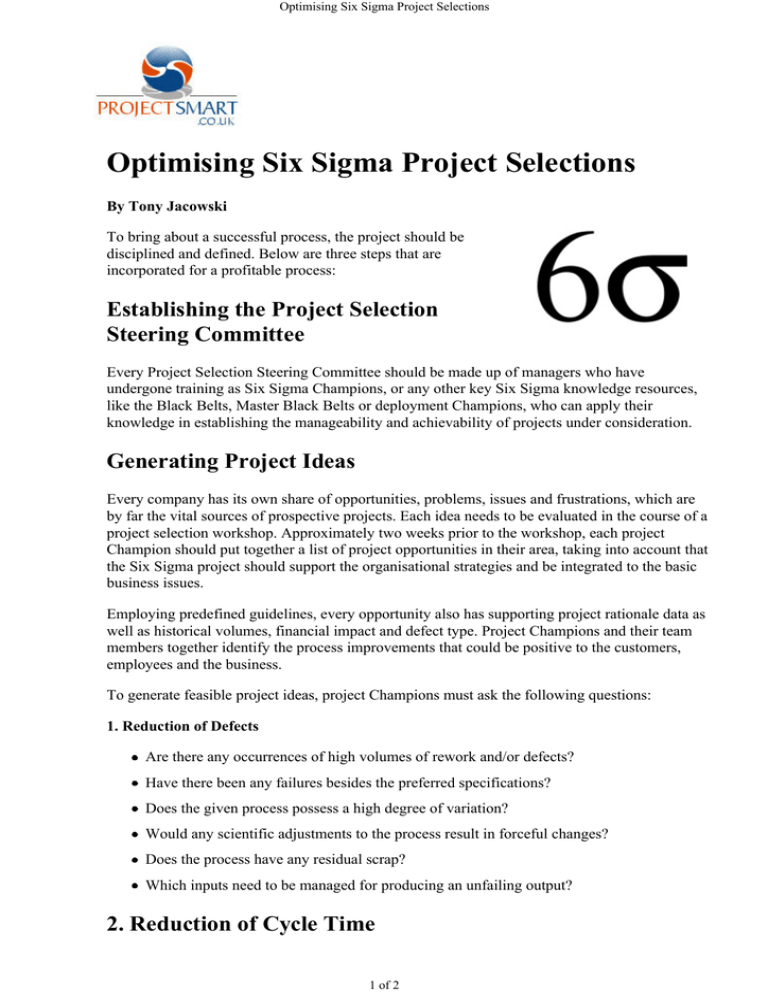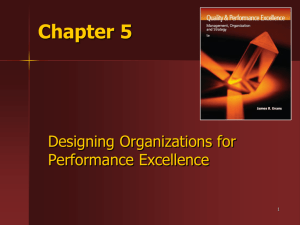Optimising Six Sigma Project Selections
advertisement

Optimising Six Sigma Project Selections Optimising Six Sigma Project Selections By Tony Jacowski To bring about a successful process, the project should be disciplined and defined. Below are three steps that are incorporated for a profitable process: Establishing the Project Selection Steering Committee Every Project Selection Steering Committee should be made up of managers who have undergone training as Six Sigma Champions, or any other key Six Sigma knowledge resources, like the Black Belts, Master Black Belts or deployment Champions, who can apply their knowledge in establishing the manageability and achievability of projects under consideration. Generating Project Ideas Every company has its own share of opportunities, problems, issues and frustrations, which are by far the vital sources of prospective projects. Each idea needs to be evaluated in the course of a project selection workshop. Approximately two weeks prior to the workshop, each project Champion should put together a list of project opportunities in their area, taking into account that the Six Sigma project should support the organisational strategies and be integrated to the basic business issues. Employing predefined guidelines, every opportunity also has supporting project rationale data as well as historical volumes, financial impact and defect type. Project Champions and their team members together identify the process improvements that could be positive to the customers, employees and the business. To generate feasible project ideas, project Champions must ask the following questions: 1. Reduction of Defects Are there any occurrences of high volumes of rework and/or defects? Have there been any failures besides the preferred specifications? Does the given process possess a high degree of variation? Would any scientific adjustments to the process result in forceful changes? Does the process have any residual scrap? Which inputs need to be managed for producing an unfailing output? 2. Reduction of Cycle Time 1 of 2 Optimising Six Sigma Project Selections Is the resultant production of the process below the one expected? Do any of the processes depend on multiple hand-offs between the individuals? Is the process being delayed because of machine/computer downtime? Does the process require a lot of overtime? 3. Reduction of Resource Consumption Does the process need more workers for doing the job? Does the process undergo a high variation in the consumption of material? After identification, project information is reviewed in a standardised quad chart format that is presented to the steering committee. Assessing and Prioritising Projects with a Project Selection Matrix In the course of the formal project selection workshop, every identified project is evaluated together for determining integration opportunities and gauging projected profits. Current ongoing projects are also included in this evaluation; thereafter all the projects are ranked for verifying the main concerns employing the project selection matrix. A key question that ought to be answered during the workshop is whether or not the project is an applicant for the DMAIC methodology. Value stream mapping design, or Lean for Six Sigma can prove to be a more appropriate methodology for a number of projects. Towards the end of the process, Black Belt resources are allocated projects on the basis of the prioritisation list. The process of project selection gives a clear-cut way of gathering suitable data from every area of the business, classifying on the basis of improvement categories and finally applying the rating for prioritisation. Every project selection process aims to establish a clear path for executing process improvements that are beneficial to the business as one. Tony Jacowski is a quality analyst for The MBA Journal. Aveta Solutions - Six Sigma Online offers online Six Sigma training and certification classes for lean www.sixsigmaonline.org Six Sigma, black belts, green belts, and yellow belts. © Project Smart 2000-2008. All rights reserved. 2 of 2




